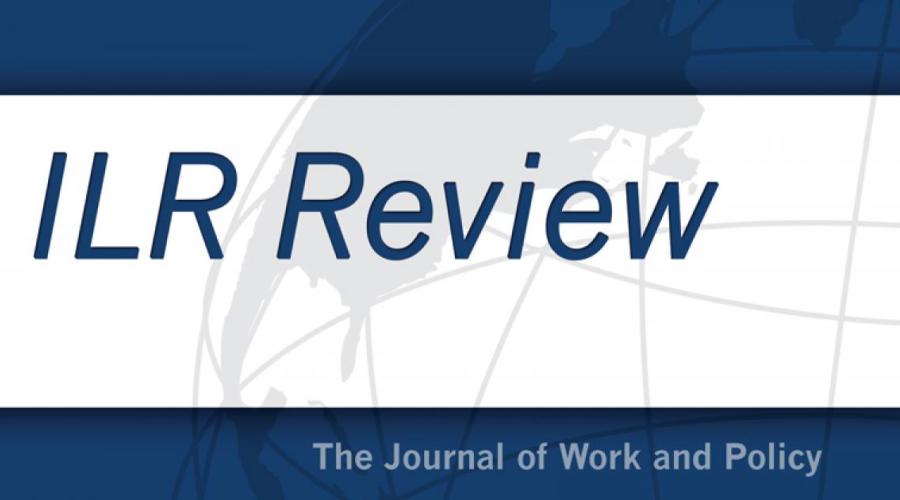
LERA Ranks ILR Review Top Employment Journal
According to a recent survey by the Labor and Employment Relations Association, the ILR Review continues to be the top journal in the field.
For more than 70 years, the Review has been at the forefront of disseminating peer-reviewed studies on work and employment relations by publishing the best empirical research on the world of work to advance theory and to inform policy and practice.
As a result of those efforts, it was rated as the best among 20 employment relation journals worldwide this past spring by professors from the U.S., Canada, the UK, Ireland, and Australia.
“Our ranking among journals in our field has always been high, and it has continued to grow in recent years through our efforts to reach a more inclusive interdisciplinary and international community; we're really proud of that,” said Professor Rosemary Batt, co-editor of the ILR Review. “Our disciplinary base has expanded to include more sociologists of labor, more political scientists, more management scholars, and more legal scholars publishing with us. We've also internationalized the journal. We have much more published from international scholars than we ever did before and we have many more people from abroad who serve as reviewers or sit on our international advisory board.”
Another key to the Review's success has been its approach of focusing on real-world problems to advance both theory and public policy. Recent articles examine the impact of technology on work, immigration, labor rights in China, social movements, inequality in the workplace, gender and racial discrimination, unemployment and its consequences, and new forms of labor market regulation. They draw on different disciplines to advance theoretical understanding and inform public policy.
“Our journal is problem-centric,” said Batt. “We start with the key issues facing working people. We take these big issues in our country and abroad, and we try to publish research that provides evidence to understand the problem and then also provide potential policy solutions.”
One such paper explores the future of truck driving in the automation age. While recent media reports have highlighted the threat of job loss due to driverless vehicles, but the study by Maury Gittleman, research economist at the U.S. Bureau of Labor Statistics, and Kristen Monaco, associate commissioner of the Office of Compensation and Working Conditions, Bureau of Labor Statistics, provides careful statistical analysis to suggest otherwise.
The authors estimate that the employment loss among U.S. truck drivers will be significantly less than the 2-3 million reported by some media. The authors found that three factors account for the inflation of these numbers, with the primary one being that the segment where automation will be the easiest to achieve also accounts for the lowest percentage of jobs in the industry. That is, long-haul trucking – which represents about 20 percent of the jobs – will be far easier to automate than short-haul trucking, which accounts for the remaining 80 percent.
“We try to address problems in a timely way,” said Batt. “Right now, many people are worried about how artificial intelligence and technology will destroy jobs. And of course, that's true, but there's probably been too much hype and not enough evidence. So, by examining the data closely, this article shows that the impact will not be nearly as great as people have expected. The trucking article helps people understand a critical problem facing many people and the potential solutions to address that problem. It’s a great example of the type of research that has helped make the Review so respected among our peers.”
For access to the ILR Review, visit: https://journals.sagepub.com/home/ilr.
For a free download of "Truck-Driving Jobs: Are They Headed for Rapid Elimination?" (Maury Gittleman and Kristen Monaco. First Published June 17, 2019), click here.
p.p1 {margin: 0.0px 0.0px 0.0px 0.0px; font: 12.0px Helvetica} p.p2 {margin: 0.0px 0.0px 0.0px 0.0px; font: 12.0px Helvetica; min-height: 14.0px} span.s1 {text-decoration: underline ; color: #0000ff} p.p1 {margin: 0.0px 0.0px 0.0px 0.0px; font: 12.0px 'Helvetica Neue'} p.p2 {margin: 0.0px 0.0px 0.0px 0.0px; font: 12.0px 'Helvetica Neue'; min-height: 14.0px} span.s1 {color: #dca10d} span.s2 {text-decoration: underline ; color: #dca10d}


